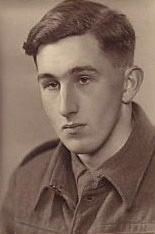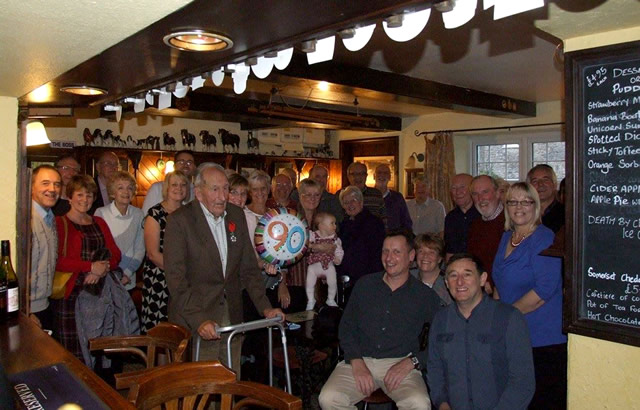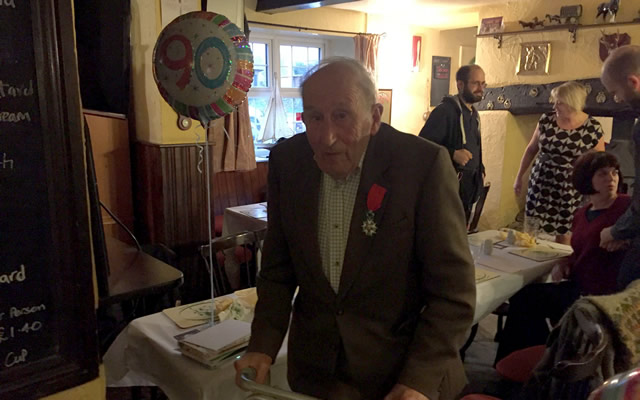Wincanton Resident’s Double Celebration
Long standing Wincanton resident John Keynes enjoyed a double celebration at the end of November. Not only did John celebrate his 90th Birthday, he also received the Légion d’Honneur from the French government for his gallant part played in the liberation of France during World War Two. This award is recognised as being the top accolade in France.
John and his late wife Ruth are fondly known by many in the town through their involvement in farming, the Red Cross, the Royal British Legion and other groups. Family and neighbours gathered at the Unicorn pub at Bayford for a surprise Sunday lunch get-together to celebrate a remarkable and honest man.
 John enlisted in 1943 at the age of 17 years. Being assigned to the General Service intake, he found himself at Colchester Barracks, home of the West Country regiments. He then went on to Deepcut with the Royal Artillery.
John enlisted in 1943 at the age of 17 years. Being assigned to the General Service intake, he found himself at Colchester Barracks, home of the West Country regiments. He then went on to Deepcut with the Royal Artillery.
After basic training John was posted to 110th Light Anti-Aircraft Regiment Royal Artillery. Prior to D-Day the regiment were stationed at West Ham Stadium, where John was able to see first-hand the German flying bombs landing on London, which was quite a frightening experience.
His unit then moved on to Folkestone and on D-Day +17 (23rd June), along with units of the 43rd Wessex Division, he landed in Normandy, having been delayed by the awful weather. The Wessex Division had lots of West Country soldiers and old TA men, predominantly from the Dorchester area.
Having dug in, the Wessex Division held a bridgehead across the River Odon and rapidly became surrounded on three sides by German Panzer units. The bridgehead shrunk to little more than the banks of the river and barely one mile wide. They were ordered to break out and capture Hill 112, which was the highest point of a ridge South West of Caen, comprised of several villages, undulating countryside and dense woods.
It was remarked that “whoever controlled Hill 112 would control Normandy”. The Germans knew this and had defended it well with seasoned troops from the 9th and 10th Panzer Division with supporting Tiger and Panther tanks. The Germans clung on desperately and when they were driven off they counter-attacked at once to regain possession.
Between 29th June and 23rd July the hill changed hands many times and thousands of Allied and German troops were killed or wounded. The 43rd Division alone lost more than 2,000 men in the first 36 hours of Operation Jupiter to regain Hill 112. John sadly remembers the Duke of Cornwell’s Light Infantry who set out with 800 men and returned with only 38 unscathed.
The attack, which began on 10th July, did finally dislodge the Germans but there was much bitter hand fighting in the waist-high corn fields. Several SS troops, manning concealed machine guns, refused to surrender but the hill was finally taken.
Having moved on from Hill 112 the next obstacle was the River Seine. The guns of John’s unit accompanied by the 4th Bn. The Wiltshire Regiment assembled near the town of Vernon on the Seine. John remembers how unreal it was and so peaceful as they were located in a garden over-looking the Seine, the birds singing.
The Wilts were sent in to clear the town and at 1845 hours a massive barrage of smoke shells was unleashed and the whole scene changed with the valley completely shrouded in smoke. Supporting units needed anti-aircraft support and artillery units had to be rapidly deployed as Luftwaffe activity was very active.
The bridges over the Seine had been blown by the Germans, and Royal Engineers had erected a bridge on boats under cover of smoke. John remembers the strange feeling of travelling over the bridge in their vehicle, towing the guns and bobbing up and down. They moved on, away from the bridge and took up positions awaiting the expected air attacks, which came in very low. Sometimes the gunners were unable to lower the guns low enough.
After crossing the Seine and moving through Belgium John’s unit found itself attached to XXX Corps and by this time it is the airborne assault at Arnhem - XXX Corps, commanded by General Sir Brian Horrocks, was spearhead on 17th September 1944 by the Guards Armoured Division. They would follow the narrow stretch of road in the direction of Eindhoven and Arnhem with the idea of linking up with the paratroopers at the bridges over the Rhine.
The progress was painfully slow as the Germans constantly harassed the British, often attempting to block the road. We all know what happened at Arnhem and sadly XXX Corps could not get there quickly enough with the resulting difficulties experienced by the paratroops. One of the incidents John remembers is reaching Nijmegen where the gunners were billeted in an abandoned house which had a supply of pickled pork. It was a great change from army rations.
He also remembers seeing another house nearby which was occupied by its owner and every time shelling brought down some slates from the roof the Dutchman would be up on the roof replacing slates. It was also at Nijmegen where the unit found a German supply train fully loaded, so it was black bread, sauerkraut and sausages for a while after that, which was also a high spot (except for the sauerkraut).
In the winter of 1944 John crossed the German border at Brunsom near Maastricht along with American troops. The weather was awful, pouring rain, and the conditions were very muddy and bleak.
The unit returned to Brunsom and the commander called an informal troop parade, when new clean uniforms were issued. The commander said he had an unpleasant task to perform and that was to select one man from the troop to transfer to the infantry. He knew of no other way to select that person so he said he would pick the youngest soldier and yes, it was John!
The good news was that John would get home leave in time for Christmas 1944 and he said at that time of the war when he got home he did not have to buy any beers until he returned to the front line.
John underwent six weeks of infantry training and then was asked which infantry regiment he would prefer. Having made friends with a Scot who had also been sent for infantry training, both had hoped for transfer to appropriate local regiments. The Scot preferred the Seaforth Highlanders and John opted for the Dorset Regiment. Posting duly came through and John was to be transferred to the Royal Scots Fusiliers (11th Battalion) and the Scot to the Duke of Cornwall’s Light Infantry. By the time John joined his new regiment, who were in Holland, the war was drawing to a close and everyone was being very careful to survive.
He was in Holland at the time of the final German surrender in May 1945. As the German troops came in to surrender word went out in the Fusiliers.
In recognition of John’s brave service, he was awarded the ‘Legion of Honour’, which arrived just one day before his surprise get-together! Accompanying his medal was a letter from the French Ambassador in London, Sylvie Bermann which read:
“I have the pleasure of informing you that the President of the Republic has appointed you to the rank of Chevalier in the Order national de la Legion d’honneur.
“I offer you my warmest congratulations on this high honour in recognition of your acknowledged military engagement and your steadfast involvement in the Liberation of France during the Second World War.
“As we contemplate this Europe of peace, we must never forget heroes like you, who came from Britain and the Commonwealth to begin liberation of Europe by liberating France. We owe our freedom and security to your dedication, because you were ready to risk your life.”


Comments
Login to comment!